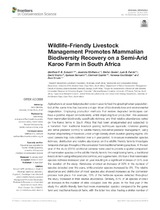| dc.description.abstract | Agriculture is an essential production system used to feed the growing human population, but at the same time has become a major driver of biodiversity loss and environmental degradation. Employing production methods that restore degraded landscapes can have a positive impact on biodiversity, whilst improving food production. We assessed how mammalian biodiversity, specifically richness and their relative abundances varied on five Karoo farms in South Africa that had been amalgamated and subjected to a transition from traditional livestock grazing techniques (sporadic rotational grazing and lethal predator control) to wildlife-friendly non-lethal predator management, using human shepherding of livestock under a high-density short-duration grazing regime. We used camera trap data collected over a 4-year period, to measure mammalian species richness, distribution and relative abundance on the wildlife-friendly farm to investigate temporal changes throughout the conversion from traditional farming practices. In the last year of the study (2019) additional cameras were used to provide a spatial comparison of mammalian species on the wildlife-friendly farm to two neighboring farms, a traditional livestock farm using lethal predator controls, and a game farm. We found that mammalian species richness increased year on year resulting in a significant increase of 24% over the duration of the study. Herbivores showed an increase of 33% in the number of species detected over the years, while predator species increased by 8%. The relative abundance and distribution of most species also showed increases as the conversion process took place. For example, 73% of the herbivore species detected throughout the study increased in their relative abundance. Similarly, 67% of all species showed an increase in the number of sites occupied over the years. In the final year of the study the wildlife-friendly farm had more mammalian species compared to the game farm and traditional livestock farm, with the latter two sites having a similar number of species when compared to the commencement of the conversion of the wildlife-friendly site. These broad improvements in mammalian biodiversity demonstrate that livestock production can benefit local mammalian biodiversity through a combination of herder grazing management and wildlife-friendly farming. | en_US |

